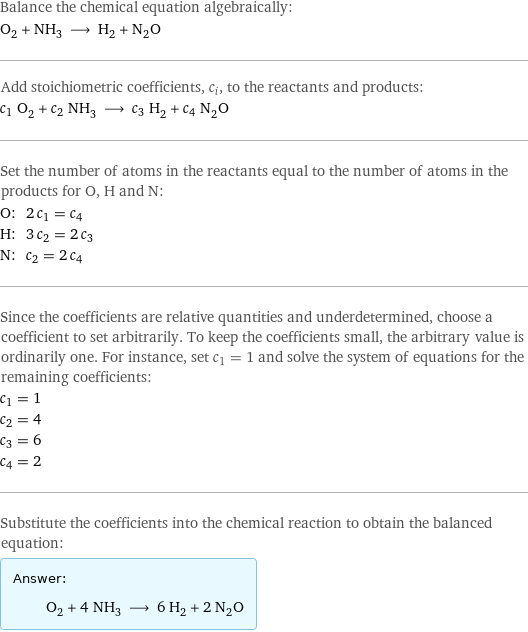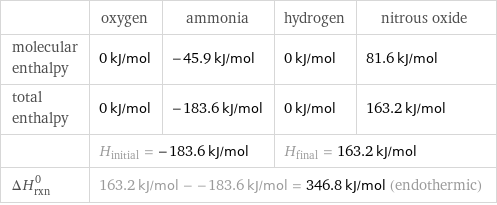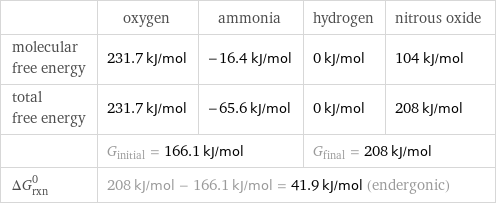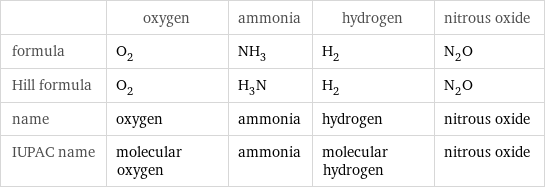Input interpretation

O_2 oxygen + NH_3 ammonia ⟶ H_2 hydrogen + N_2O nitrous oxide
Balanced equation

Balance the chemical equation algebraically: O_2 + NH_3 ⟶ H_2 + N_2O Add stoichiometric coefficients, c_i, to the reactants and products: c_1 O_2 + c_2 NH_3 ⟶ c_3 H_2 + c_4 N_2O Set the number of atoms in the reactants equal to the number of atoms in the products for O, H and N: O: | 2 c_1 = c_4 H: | 3 c_2 = 2 c_3 N: | c_2 = 2 c_4 Since the coefficients are relative quantities and underdetermined, choose a coefficient to set arbitrarily. To keep the coefficients small, the arbitrary value is ordinarily one. For instance, set c_1 = 1 and solve the system of equations for the remaining coefficients: c_1 = 1 c_2 = 4 c_3 = 6 c_4 = 2 Substitute the coefficients into the chemical reaction to obtain the balanced equation: Answer: | | O_2 + 4 NH_3 ⟶ 6 H_2 + 2 N_2O
Structures

+ ⟶ +
Names

oxygen + ammonia ⟶ hydrogen + nitrous oxide
Reaction thermodynamics
Enthalpy

| oxygen | ammonia | hydrogen | nitrous oxide molecular enthalpy | 0 kJ/mol | -45.9 kJ/mol | 0 kJ/mol | 81.6 kJ/mol total enthalpy | 0 kJ/mol | -183.6 kJ/mol | 0 kJ/mol | 163.2 kJ/mol | H_initial = -183.6 kJ/mol | | H_final = 163.2 kJ/mol | ΔH_rxn^0 | 163.2 kJ/mol - -183.6 kJ/mol = 346.8 kJ/mol (endothermic) | | |
Gibbs free energy

| oxygen | ammonia | hydrogen | nitrous oxide molecular free energy | 231.7 kJ/mol | -16.4 kJ/mol | 0 kJ/mol | 104 kJ/mol total free energy | 231.7 kJ/mol | -65.6 kJ/mol | 0 kJ/mol | 208 kJ/mol | G_initial = 166.1 kJ/mol | | G_final = 208 kJ/mol | ΔG_rxn^0 | 208 kJ/mol - 166.1 kJ/mol = 41.9 kJ/mol (endergonic) | | |
Entropy

| oxygen | ammonia | hydrogen | nitrous oxide molecular entropy | 205 J/(mol K) | 193 J/(mol K) | 115 J/(mol K) | 220 J/(mol K) total entropy | 205 J/(mol K) | 772 J/(mol K) | 690 J/(mol K) | 440 J/(mol K) | S_initial = 977 J/(mol K) | | S_final = 1130 J/(mol K) | ΔS_rxn^0 | 1130 J/(mol K) - 977 J/(mol K) = 153 J/(mol K) (endoentropic) | | |
Equilibrium constant
![Construct the equilibrium constant, K, expression for: O_2 + NH_3 ⟶ H_2 + N_2O Plan: • Balance the chemical equation. • Determine the stoichiometric numbers. • Assemble the activity expression for each chemical species. • Use the activity expressions to build the equilibrium constant expression. Write the balanced chemical equation: O_2 + 4 NH_3 ⟶ 6 H_2 + 2 N_2O Assign stoichiometric numbers, ν_i, using the stoichiometric coefficients, c_i, from the balanced chemical equation in the following manner: ν_i = -c_i for reactants and ν_i = c_i for products: chemical species | c_i | ν_i O_2 | 1 | -1 NH_3 | 4 | -4 H_2 | 6 | 6 N_2O | 2 | 2 Assemble the activity expressions accounting for the state of matter and ν_i: chemical species | c_i | ν_i | activity expression O_2 | 1 | -1 | ([O2])^(-1) NH_3 | 4 | -4 | ([NH3])^(-4) H_2 | 6 | 6 | ([H2])^6 N_2O | 2 | 2 | ([N2O])^2 The equilibrium constant symbol in the concentration basis is: K_c Mulitply the activity expressions to arrive at the K_c expression: Answer: | | K_c = ([O2])^(-1) ([NH3])^(-4) ([H2])^6 ([N2O])^2 = (([H2])^6 ([N2O])^2)/([O2] ([NH3])^4)](../image_source/1eec32cb6a680cf72da45d5e47e2f0c2.png)
Construct the equilibrium constant, K, expression for: O_2 + NH_3 ⟶ H_2 + N_2O Plan: • Balance the chemical equation. • Determine the stoichiometric numbers. • Assemble the activity expression for each chemical species. • Use the activity expressions to build the equilibrium constant expression. Write the balanced chemical equation: O_2 + 4 NH_3 ⟶ 6 H_2 + 2 N_2O Assign stoichiometric numbers, ν_i, using the stoichiometric coefficients, c_i, from the balanced chemical equation in the following manner: ν_i = -c_i for reactants and ν_i = c_i for products: chemical species | c_i | ν_i O_2 | 1 | -1 NH_3 | 4 | -4 H_2 | 6 | 6 N_2O | 2 | 2 Assemble the activity expressions accounting for the state of matter and ν_i: chemical species | c_i | ν_i | activity expression O_2 | 1 | -1 | ([O2])^(-1) NH_3 | 4 | -4 | ([NH3])^(-4) H_2 | 6 | 6 | ([H2])^6 N_2O | 2 | 2 | ([N2O])^2 The equilibrium constant symbol in the concentration basis is: K_c Mulitply the activity expressions to arrive at the K_c expression: Answer: | | K_c = ([O2])^(-1) ([NH3])^(-4) ([H2])^6 ([N2O])^2 = (([H2])^6 ([N2O])^2)/([O2] ([NH3])^4)
Rate of reaction
![Construct the rate of reaction expression for: O_2 + NH_3 ⟶ H_2 + N_2O Plan: • Balance the chemical equation. • Determine the stoichiometric numbers. • Assemble the rate term for each chemical species. • Write the rate of reaction expression. Write the balanced chemical equation: O_2 + 4 NH_3 ⟶ 6 H_2 + 2 N_2O Assign stoichiometric numbers, ν_i, using the stoichiometric coefficients, c_i, from the balanced chemical equation in the following manner: ν_i = -c_i for reactants and ν_i = c_i for products: chemical species | c_i | ν_i O_2 | 1 | -1 NH_3 | 4 | -4 H_2 | 6 | 6 N_2O | 2 | 2 The rate term for each chemical species, B_i, is 1/ν_i(Δ[B_i])/(Δt) where [B_i] is the amount concentration and t is time: chemical species | c_i | ν_i | rate term O_2 | 1 | -1 | -(Δ[O2])/(Δt) NH_3 | 4 | -4 | -1/4 (Δ[NH3])/(Δt) H_2 | 6 | 6 | 1/6 (Δ[H2])/(Δt) N_2O | 2 | 2 | 1/2 (Δ[N2O])/(Δt) (for infinitesimal rate of change, replace Δ with d) Set the rate terms equal to each other to arrive at the rate expression: Answer: | | rate = -(Δ[O2])/(Δt) = -1/4 (Δ[NH3])/(Δt) = 1/6 (Δ[H2])/(Δt) = 1/2 (Δ[N2O])/(Δt) (assuming constant volume and no accumulation of intermediates or side products)](../image_source/83bd28339263df4b026a37b6bb5df237.png)
Construct the rate of reaction expression for: O_2 + NH_3 ⟶ H_2 + N_2O Plan: • Balance the chemical equation. • Determine the stoichiometric numbers. • Assemble the rate term for each chemical species. • Write the rate of reaction expression. Write the balanced chemical equation: O_2 + 4 NH_3 ⟶ 6 H_2 + 2 N_2O Assign stoichiometric numbers, ν_i, using the stoichiometric coefficients, c_i, from the balanced chemical equation in the following manner: ν_i = -c_i for reactants and ν_i = c_i for products: chemical species | c_i | ν_i O_2 | 1 | -1 NH_3 | 4 | -4 H_2 | 6 | 6 N_2O | 2 | 2 The rate term for each chemical species, B_i, is 1/ν_i(Δ[B_i])/(Δt) where [B_i] is the amount concentration and t is time: chemical species | c_i | ν_i | rate term O_2 | 1 | -1 | -(Δ[O2])/(Δt) NH_3 | 4 | -4 | -1/4 (Δ[NH3])/(Δt) H_2 | 6 | 6 | 1/6 (Δ[H2])/(Δt) N_2O | 2 | 2 | 1/2 (Δ[N2O])/(Δt) (for infinitesimal rate of change, replace Δ with d) Set the rate terms equal to each other to arrive at the rate expression: Answer: | | rate = -(Δ[O2])/(Δt) = -1/4 (Δ[NH3])/(Δt) = 1/6 (Δ[H2])/(Δt) = 1/2 (Δ[N2O])/(Δt) (assuming constant volume and no accumulation of intermediates or side products)
Chemical names and formulas

| oxygen | ammonia | hydrogen | nitrous oxide formula | O_2 | NH_3 | H_2 | N_2O Hill formula | O_2 | H_3N | H_2 | N_2O name | oxygen | ammonia | hydrogen | nitrous oxide IUPAC name | molecular oxygen | ammonia | molecular hydrogen | nitrous oxide
Substance properties

| oxygen | ammonia | hydrogen | nitrous oxide molar mass | 31.998 g/mol | 17.031 g/mol | 2.016 g/mol | 44.013 g/mol phase | gas (at STP) | gas (at STP) | gas (at STP) | gas (at STP) melting point | -218 °C | -77.73 °C | -259.2 °C | -91 °C boiling point | -183 °C | -33.33 °C | -252.8 °C | -88 °C density | 0.001429 g/cm^3 (at 0 °C) | 6.96×10^-4 g/cm^3 (at 25 °C) | 8.99×10^-5 g/cm^3 (at 0 °C) | 0.001799 g/cm^3 (at 25 °C) surface tension | 0.01347 N/m | 0.0234 N/m | | 0.00175 N/m dynamic viscosity | 2.055×10^-5 Pa s (at 25 °C) | 1.009×10^-5 Pa s (at 25 °C) | 8.9×10^-6 Pa s (at 25 °C) | 1.491×10^-5 Pa s (at 25 °C) odor | odorless | | odorless |
Units
